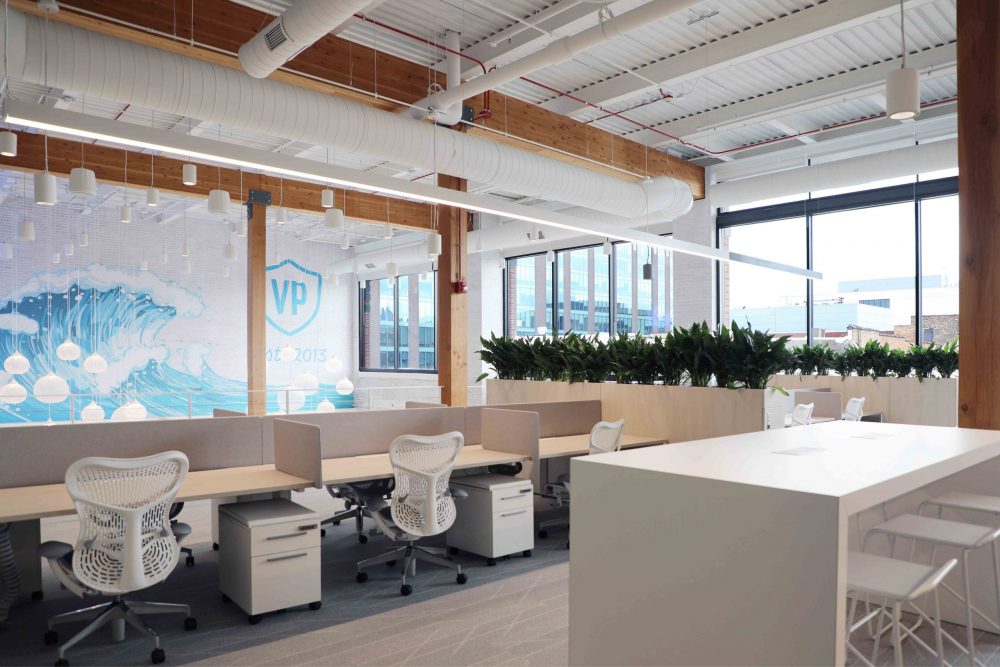Ten office updates recommended to support a healthy return to work.
This summer many offices are starting to reopen. They are considering all their options to make a safe and healthy return to work for employees. However, the threat of COVID-19 is still present! It will require a careful, vigilant and ongoing plan to ensure a workplace that’s the safest it can be. Companies will need to do more than put hand sanitizer dispensers everywhere and rearrange desks to put employees’ minds at ease.
Some safety measures may require a company to consult their architect and general contractor to implement renovations. The alterations may be from small face-lifts to more significant structural updates.
Regardless of whether your company is heading back into the office ASAP or still managing a remote workforce, there’s still time to make updates with no or little disruption to your return-to-work timeline. Here are 10 recommended office updates to support a healthy return to work:
- Dedicate separate rooms for deliveries and visitors.
By designating or creating distinct spaces – one for packages/deliveries and another for visitors – employees can limit contact with people coming into the office. Keeping deliveries as contactless as possible by using applications to manage them can also reduce transmission from outside the office.
- Make the most out of reception.
Turn the reception area into a multipurpose space for employees. They can sanitize their hands, have their temperatures taken, and pick up safety equipment like face masks and sanitizing wipes. It can also be the checkpoint and physical reminder for where the “new normal” starts, with prominently placed signs featuring instructions and directions on how employees should interact with each other.
- Install signage and floor graphics to demonstrate where and how employees should move through the office.
While most employees know they should be keeping distance between each other, it’s sometimes hard to know exactly how far apart that is. A the regular reminder doesn’t hurt. Placing stickers on the floor to indicate this distance, or arrows in hallways to determine which way people should be flowing through, can help employees maintain proper distance and avoid crowding in tight areas.
- Add keycard-operated automatic doors to reduce touch-shared surfaces.
Limiting the number of high-touch surfaces is a key tactic of containment. Door handles are one of the most touched surfaces in an office. Automatic doors activated by keycards or ID badges can eliminate the need for those risky surfaces. This is a bigger financial lift, but is worth considering for longer-term health and safety of the office.
- Divide break areas and spread out pantries.
The central kitchen and eating area of yesterday’s open office will need to be broken up to curb virus spread. By installing smaller pantry areas around the office, employees can still access these spots without gathering in large groups. Spreading out smaller kitchenettes with sinks provides more handwashing stations, too. You don’t have to close off lounge-type spaces, but spread the seating to encourage distancing or smaller pods rather than gatherings. Similarly, maximizing your company’s use of any outdoor space, which many health experts consider safer, by making them tech-ready is another away-from-the-desk option.
- Upgrade HVAC systems.
Since coronavirus particles travel through the air, HVAC systems should be a major focus of reopening efforts. Upgrading HVAC systems with the ability to more carefully filter air and limit widespread circulation can reduce disease spread. This will likely be controlled by the building owner when leasing or subleasing space in a multi-unit building, so it’s worth bringing up when coordinating the reopen.
- Separate benching systems or add dividers between desks.
Breaking up current benching systems and spacing them out six feet apart and/or adding dividers between desks that can’t be spaced out can ensure employees are adequately spread out. Adding dividers can be a quick installation or require a heavier lift to build more substantial partitions, depending on the route you want to take.
Check out WDM’s roundup of the newest separation solutions here!
- Add wall-mounted monitors and cameras in conference rooms.
Even when offices reopen, many firms won’t bring back all employees or will institute alternating on-site and at-home schedules – so collaborating with the remote workers will require enhanced digital collaboration. Installing tools to promote digital work can naturally facilitate that collaboration.
- Build out new rows of phone booths.
Creating new enclosed spaces for employees to take calls can serve the dual purpose of promoting virtual collaboration with remote teams and boosting office health. Placing hand sanitizer and wipes near these booths encourages employees to keep them clean, too.
- Rearrange existing or install new furniture.
Outside of rearranging desks, other office furniture can be spaced out to provide additional seating for employees while promoting social distancing. New furniture with resilient and easy-to-clean materials and surfaces can also improve cleanliness. As comfort has become a key element to working from home, furniture with comfortable materials can ease employees’ transition back to the office.
While the immediate impacts of the coronavirus pandemic have quickly disrupted all aspects of daily life – including the office environment – the long-term effects are still forming. Plus, the threat of COVID-19 will likely exist for an indefinite period of time, even as business must go on. We anticipate that these healthy return to work considerations won’t just be temporary fixes, but rather will last past this crisis and transform the workplace for the healthier and better. Investing in these office renovations now will demonstrate to employees that their health and safety is important not just for the near term, but for the long haul.
Article written by Clay Edwards of Skender, Chicago

